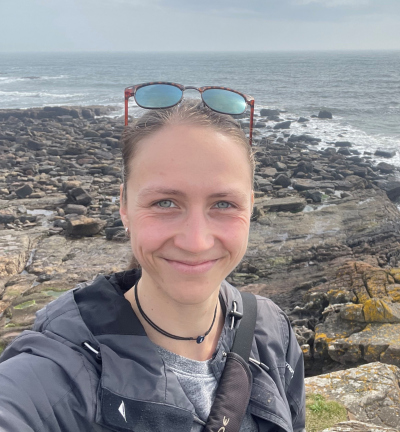- Startseite
- Victoria Kürzinger
Dr. Victoria Kürzinger |
|
|
Postdoktorand_innen |
|
|
Gruppe: |
Organische Geochemie |
|
Telefon: |
|
|
E-Mail: |
|
|
Raum: |
MARUM I, 2690 |

Scientific Career
| Since 2023 |
Postdoc at MARUM - Center for Marine Environmental Sciences, |
| 2019 - 2022 |
PhD student at University of Bremen/MARUM, |
| 2016 - 2019 |
University of Bremen, Marine Geosciences, |
| 2013 - 2016 |
TU Bergakademie Freiberg, Geology/Mineralogy, |
Publications
- Kürzinger, V.; Römer, M.; Lichtschlag, A.; Bohrmann, G. (2023): Seafloor investigations of the Kemp Caldera, the southernmost arc caldera volcano from the South Sandwich island arc. Geochemistry, Geophysics, Geosystems, 24, e2023GC011024.
doi:10.1029/2023GC011024
- Kürzinger, V.; Hansen, C.T.; Strauss, H.; Wu, S.; Bach, W. (2023): Experimental evidence for the hydrothermal formation of native sulfur by synproportionation. Frontiers in Earth Science, 11, 724.
doi:10.3389/feart.2023.1132794
- Kürzinger, V.; Diehl, A.; Pereira, S.I.; Strauss, H.; Bohrmann, G.; Bach, W. (2022): Sulfur formation associated with coexisting sulfide minerals in the Kemp Caldera hydrothermal system, Scotia Sea. Chemical Geology, 606, 120927.
doi:10.1016/j.chemgeo.2022.120927
Postdoc Project
Geosphere-biosphere interactions in geothermally heated subseafloor sediments
The deep biosphere in marine sediments extends up to several kilometers into the ocean floor and is often situated at temperatures close to the upper limit of life. At these temperatures, sedimentary organic matter undergoes thermogenic alteration that may supply a steady flow of metabolizable substrates for fueling (hyper-)thermophilic microbial life. However, the quantities and the spectrum of potential metabolic substrates, the kinetics and mechanisms of the underlying reactions, and the alteration of the residual organic matter pool are essentially unknown.
Within this project, which is part of the EXC research area REACTOR, hydrous pyrolysis experiments will be performed to study the reactions of sedimentary organic compounds under hydrothermal conditions. The sediment samples are from the Juan de Fuca Ridge, various sites at the Nankai Trough, and the Guaymas Basin and were situated at in-situ temperatures of up to 120 °C. The technical objective is to determine the release of potential substrates for microbial metabolism as a function of sediment type, organic matter content and the sediments temperature history. Isothermal samples from different sites will be investigated at pyrolysis temperatures ranging from 250 to 350 °C to quantify the amounts of released low-molecular weight substrates and dissolved organic matter (DOM). The released DOM will be examined by ultra-high-resolution mass spectrometry and fluorescence spectroscopy and referenced against the initially available pool of DOM. Selected experiments will be amended with stable-isotope-labeled compounds, e.g., deuterated water, or 13C bicarbonate, to clarify the underlying reaction mechanisms of substrate release. In summary, the project will address some of the REACTOR’s key questions related to chemical fluxes and habitability within the deep ocean floor.


